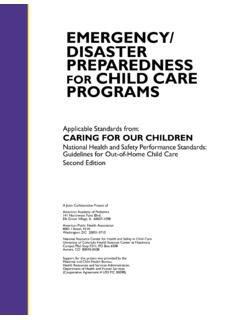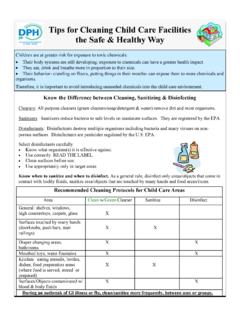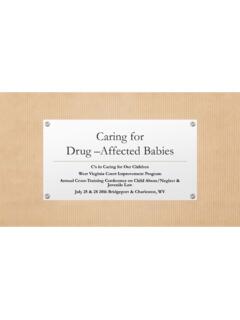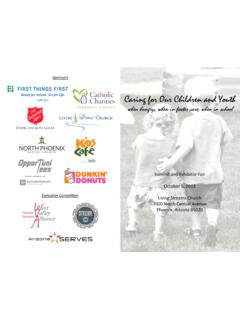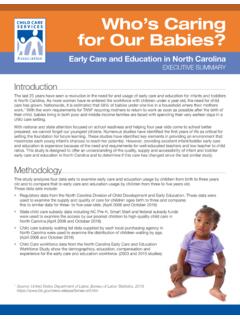Transcription of Diaper Procedure - List of Steps (See Poster)
1 1 Diaper Procedure - List of Steps (See Poster) The following Diaper changing Procedure is recommended and should be posted in the changing area and followed for all Diaper changes. Caregivers should never leave a child alone on a table or countertop, even for an instant. A safety strap or harness, is neither sanitary nor safe, should not be used on the Diaper changing table. If an emergency arises, caregivers should put the child on the floor or take the child with them. step 1: Get organized. Before you bring the child to the Diaper changing area, wash your hands, gather and bring what you need to the Diaper changing table: o Non-absorbent paper liner large enough to cover the changing surface from the child's shoulders to beyond the child's feet.
2 O Fresh Diaper , clean clothes (if you need them). o Wipes for cleaning the child's genitalia and buttocks removed from the container or dispensed so the container will not be touched during Diaper changing. o A plastic bag for any soiled clothes. o Disposable gloves, if you plan to use them o A thick application of any Diaper cream (when appropriate) removed from the container to a piece of disposable material such as facial or toilet tissue. o Put on disposable gloves. step 2: Carry the child to the changing table, keeping soiled clothing away from you and any surfaces you cannot easily clean and sanitize after the change. o Gently place child on diapering surface. o Always keep a hand on the child.
3 O If the child's feet cannot be kept out of the Diaper or from contact with soiled skin during the changing process, remove the child's shoes and socks so the child does not contaminate these surfaces with stool or urine during the Diaper changing. o Put soiled clothes in a plastic bag and securely tie the plastic bag to send the soiled clothes home. o Do not rinse step 3: Clean the child's Diaper area. o Unfasten the Diaper but leave the soiled Diaper under the child. o If safety pins are used, close each pin immediately once it is removed and keep pins out of the child's reach. Never hold pins in your mouth. o Remove stool and urine from front to back and use a fresh wipe each time.
4 Lift the child's legs as needed to use disposable wipes to clean the skin on the child's genitalia and buttocks. Put the soiled wipes into the soiled Diaper or directly into a plastic-lined, hands-free covered can. 2 step 4: Remove the soiled Diaper without contaminating any surface not already in contact with stool or urine. o Fold the soiled surface of the Diaper inward. o Immediately put soiled disposable diapers in a covered, plastic-lined, hands-free covered can. o Put the soiled cloth Diaper and its contents (without emptying or rinsing) in a plastic bag or into a plastic-lined, hands-free covered can to give to parents or laundry service. o If gloves were used, remove them using the proper technique (see Gloving Procedure ) and immediately put them into a plastic-lined, hands-free covered can.
5 O Whether or not gloves were used, use a disposable wipe to clean the surfaces of the caregiver's hands and another to clean the child's hands, and put the wipes into the plastic-lined, hands-free covered can. o Check for spills under the child. If there are any, use the paper that extends under the child's feet to fold over the disposable paper so a fresh, unsoiled paper surface is now under the child's buttocks. Note: Gloves must be worn when blood or bodily fluids containing blood are present. step 5: Put on a clean Diaper and dress the child. o Slide a fresh Diaper under the child. o Use a facial or toilet tissue to apply any necessary Diaper creams, discarding the tissue in a covered, plastic-lined, hands-free covered can.
6 O Note and plan to report any skin problems such as redness, skin cracks, or bleeding. o Fasten the Diaper . If pins are used, place your hand between the child and the Diaper when inserting the pin. step 6: Wash the child's hands and return the child to a supervised area. o Use soap and water, no less than 60 degrees F and no more than 120 degrees F, at a sink to wash the child's hands, if you can. o If a child is too heavy to hold for handwashing or cannot stand at the sink, use commercial disposable Diaper wipes or follow this Procedure : Wipe the child's hands with a damp paper towel moistened with a drop of liquid soap. Wipe the child's hands with a paper towel wet with clear water.
7 Dry the child's hands with a paper towel; and toss paper towel into a plastic-lined, hands free covered can. Return child to supervised area. 3 step 7: Clean and sanitize the Diaper -changing surface. o Dispose of the disposable paper liner used on the Diaper changing surface in a plastic-lined, hands-free covered can. o Clean any visible soil from the changing surface with detergent and water; If a pad is used, spray both sides of the pad and the changing table surface with detergent solution. Rinse with water. o Wet the entire changing surface with the sanitizing solution ( spray a sanitizing bleach solution of cup of household liquid chlorine bleach in one gallon of tap water, mixed fresh daily).
8 Spray both sides of the o pad and the changing table surface with a disinfecting solution. o If the recommended bleach dilution is sprayed as a sanitizer on the surface, leave it in contact with the surface for at least 2 minutes. The surface can be left to air dry or can be wiped dry after 2 minutes of contact with the bleach solution. step 8: Wash your hands o Put cleaning and disinfecting solutions away. o Wash your hands. step 9: Record the Diaper change in the child's daily log. o In the daily log, record what was in the Diaper and any problems (such as a loose stool, an unusual odor, blood in the stool, or any skin irritation). Report as necessary How to help your caregiver with this topic Review with your caregiver their diapering procedures ; Watch your caregiver change diapers.
9 Do you notice any problems (caregiver's back straining while lifting, other children unsupervised, supplies not convenient, etc.)? If so, can you see solutions to the problems? Do you know someone who could help adapt the diapering environment? Keep an abundant supply of diapers and clean clothes in your child's Diaper bag. Print off posters in this section and give to your caregiver for possible display in the Diaper changing area. 4 Additional Resources Diapering Poster (Global Healthy Child Care) Diapering Poster (California Child Health Program) English Spanish Research 13 Indicators of Quality Child Care: Research Update: Diapering #Handwashing Based on caring for Our children : National Health and Safety Performance Standards: Guidelines for Out-of-Home Child Care Programs, 2nd Edition, 2002 (American Academy of Pediatrics, American Public Health Association, and National Resource Center for Health and Safety in Child Care) Healthy Kids, Healthy Care: Diapering National Resource Center for Health and Safety in Child Care 1-800-598-5437
